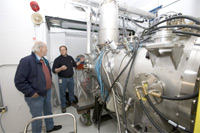 |
|||||||||||
|
|||||||||||
|
|||||||||||
On Monday, 6 February, a team of cryogenic engineers and accelerator physicists at Fermilab successfully cooled the first TESLA 9-cell 1.3 GHz cavity to 4.5 K (Kelvin) in the ILC Test Area in the Meson Detector Building (ILCTA-MDB). Travelling to Hamburg, Germany, Fermilab personnel assisted DESY in preparing the "ILC-like" cavity, called Capture Cavity II (CCII), and shipped it to its current home in Batavia, Illinois in August 2005. "We cooled it down to verify the resonant frequency of the cavity and to test a piezo-electric 'fast' tuner. The cryogenic system worked flawlessly," said Fermilab's Tim Koeth, a graduate student at Rutgers University who is working on CCII as part of his thesis. A 200 kW (kilowatt) klystron provides the RF (radiofrequency) power to the cavity, which currently lives in a "cave" for cryogenics testing in the ILCTA-MDB. Koeth and other members of the group will continue to test the CCII by measuring the Q (quality factor of resonance) measurement and peak accelerating field inside the cavity to make sure it performs as well here as it did at DESY. After testing is complete, CCII will move to the photoinjector. Inside the photoinjector, it will be put downstream of another superconducting cavity already in place to upgrade the energy from 15 MeV (million electron volts) to 40 MeV. Cooling the cavity down to 4.5 K is the result of a tremendous amount of manpower and collaboration between several different laboratories. When work first started on the ILCTA-MDB about a year ago, the cryogenic lines actually had to be extended about 1100 feet to reach the test facility. In order to save money and time, Fermilab's cryogenic engineers reused as much equipment as they could from older fixed-target experiments. Installing transfer lines is not a simple task though. "Transfer lines are a series of concentric pipes," said Fermilab cryogenic engineer Arkadiy Klebaner. "Helium has a very low latent heat, which means it takes very little heat to convert it from liquid to vapour. Multi layer superinsulation, a vacuum and a nitrogen shield reduce helium heat loss. Nitrogen also has a low heat capacity but not as sensitive as helium." Because the transfer lines are a series of pipes within pipes, engineers started from the inside and worked their way out, making sure that the necessary vacuum remained in tact. Because pipes will contract as they cool, engineers also installed expansion boxes to maintain structural integrity of the lines as the temperature decreases. With assistance of colleagues from SLAC, who helped with components' design, it took the group nine months to put the cryogenic system together. In September 2005, engineers delivered cryogens to the ILCTA-MDB for the first time. "Delivering cryogens into the building from 1100 feet away was a big step," said Fermilab cryogenic engineer Jay Theilacker. "It was especially exciting when we had the opportunity to cool the Capture Cavity down, and it was a great milestone for everyone. We are now working on getting transfer lines installed for the horizontal test cave in the test facility." Both Theilacker and Klebaner, not to mention the rest of the team, already have their eyes set on the next goal -- cooling the cavity down to its normal operating temperature of 1.8 K, which they expect to achieve this spring. "We have a long way to go, but these first steps were crucial. We delivered cryogens, and we didn't break anything," Klebaner said with a grin.-- Elizabeth Clements |
|||||||||||
| © International Linear Collider |
